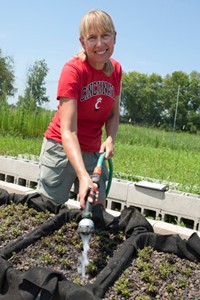
Native Plant Fares Well in Pilot Green Roof Research Study
As the implementation of green roofs increase, a University of Cincinnati pilot study examined which plants best thrive on the regions roofs during the dry, hot conditions of summer.
That research, by UC biology student Jill Bader and Ishi Buffam, assistant professor of biology, identified a North American (and Ohio) native plant nodding wild onion (Allium cernuum) and a European sedum (Sedum acre, also known as goldmoss sedum) as suited to survive and thrive on the regions green roofs.
Their research will be presented in a paper titled Ohio Native Plants On a Green Roof: Evaluation of Survival and Impact on Stormwater Runoff at the CitiesAlive 2012 conference, sponsored by Green Roofs for Healthy Cities Oct. 17-20 in Chicago.
Our research will help inform the design of green roofs specific for this region, and therefore increase their chances of being successful, and being adopted in Midwestern cities. There are many potential benefits to green roofs, including building energy savings, extension of roof life, reduced air and noise pollution, creation of environment for native birds and insects and, of course, reduced storm water runoff, said Buffam.
Bader and Buffam tested four Ohio native plants and one sedum to see which was the most likely to survive on an extensive green roof in the late summer of 2011. All plants were tested under two conditions: dependent on rainfall only and receiving regular watering. The testing took place at the Cincinnati Center for Field Studies in Harrison, Ohio.
All plants receiving regular watering survived.
However, heath aster (Aster ericoides), flowering spurge (Euphorbia corollata) and lanced-leaved loosestrife (Lysimachia lanceolata)
did not survive when receiving rainfall as their only water source.
When receiving only rainfall, the nodding wild onion (A. cernuum) and the goldmoss sedum (S. acre) were stressed but survived.
All of these plants were selected for testing because their natural habitat is prairie or meadow, where exposure to full sun and dry conditions are typical.
According to Bader, We tested the plants because one of the most critical choices for the success of a green roof is the choice of plant species. The environment on a rooftop is characterized by severe drought, elevated temperatures, high light intensity, high winds and the layer of soil for the plants is generally shallower than it would be for plants in typical settings.
In fact, a contributing factor in the success of S. acre and A. cernuum to survive was shallow root systems, paired with characteristics that allow them to efficiently use water during hot, dry conditions. In the case of A. cernuum, its a bulb which can store water for later use by the plant, and in the case of S. acre, its the relatively thick foliage and CAM photosynthesis. (CAM photosynthesis is an adaptation by plants living in arid conditions that allows stoma or tiny pores in the foliage to close during the day in order to retain moisture but opening at night in order to complete part of the photosynthesis process.)
Bader and Buffam added that environmental conditions vary widely by geographic regions in North America. There are hundreds of eco-regions in North America, and that demands study of which plants work best in each region.
In addition to testing which Ohio native plants could best survive on an extensive green roof, Bader and Buffam also tested the impact of plant species to reduce water runoff, one of the important functions of a green roof. (In other words, which of the tested plants best retained water, such that the water was absorbed vs. running into the sewer system.)

UC's Ishi Buffam and Jill Bader
In this preliminary test, the native species receiving moisture only from rainfall (vs. regular watering) retained 51 percent of rainfall on average, but there was no significant difference among the species in their abilities to absorb water and reduce total runoff quantity. Those plants receiving regular watering retained 44 percent of rainfall on average.
This pilot study was supported by UCs Julia Hammler Wendell Scholarship Fund, Women in Science and Engineering (WISE) Program and Cincinnati Center for Field Studies at Miami Whitewater Forest, a research station partnership between the University of Cincinnati and the Hamilton County Park District.
Related Stories
Jason and Travis Kelce take Cincinnati to ‘New Heights’
April 16, 2024
UC alumni Jason and Travis Kelce returned to UC for an unforgettable evening that included the Great "Lombaby" Games, a live recording of their podcast "New Heights," special guests Joe Burrow, Orlando Brown Jr. and Desmond Ridder and a surprise commencement ceremony.
UC President Neville Pinto shares 2024 State of the University...
April 16, 2024
University of Cincinnati President Neville G. Pinto shared his 2024 Sate of the University address with the campus community on April 15.
Local 12: Nature still healing after Tristate storm that killed 4
April 12, 2024
Local 12 and other news media highlighted a long-term study by the University of Cincinnati examining the recovery of a forest damaged by a deadly tornado 25 years ago. The study found that the storm provided an opportunity for some nonnative, invasive species.
